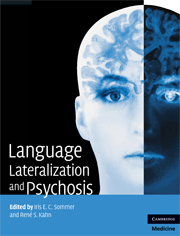Crossref Citations
This Book has been
cited by the following publications. This list is generated based on data provided by Crossref.
Badcock, Johanna C.
and
Hugdahl, Kenneth
2012.
Hallucinations.
p.
317.
Rapp, Alexander M.
Langohr, Karin
Mutschler, Dorothee E.
Klingberg, Stefan
Wild, Barbara
Erb, Michael
and
Zang, Yu-Feng
2013.
Isn’t it ironic? Neural Correlates of Irony Comprehension in Schizophrenia.
PLoS ONE,
Vol. 8,
Issue. 9,
p.
e74224.
Sandu, A.‐L.
Paillère Martinot, M.‐L.
Artiges, E.
and
Martinot, J.‐L.
2014.
1910s' brains revisited. Cortical complexity in early 20th century patients with intellectual disability or with dementia praecox.
Acta Psychiatrica Scandinavica,
Vol. 130,
Issue. 3,
p.
227.
Botha, Rudolf
2020.
Neanderthal Language.
Cuevas, Paulina
He, Yifei
Steines, Miriam
and
Straube, Benjamin
2022.
The Processing of Semantic Complexity and Cospeech Gestures in Schizophrenia: A Naturalistic, Multimodal fMRI Study.
Schizophrenia Bulletin Open,
Vol. 3,
Issue. 1,
Babik, Iryna
and
Lobo, Michele A.
2023.
Hand-Use Preferences for Reaching and Object Exploration in Children with Impaired Upper Extremity Functioning: The Role of Environmental Affordances.
Symmetry,
Vol. 15,
Issue. 12,
p.
2161.
Payette, Julie
Vaussenat, Fabrice
and
Cloutier, Sylvain G.
2024.
Heart Rate Measurement Using the Built-In Triaxial Accelerometer from a Commercial Digital Writing Device.
Sensors,
Vol. 24,
Issue. 7,
p.
2238.
Giovagnoli, Anna Rita
and
Parisi, Alessandra
2024.
Fifty Years of Handedness Research: A Neurological and Methodological Update.
Brain Sciences,
Vol. 14,
Issue. 5,
p.
418.





